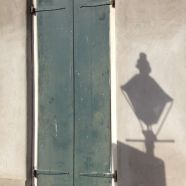Poems from Bellocq’s Ophelia
Excerpted from Bellocq’s Ophelia
Ophelia is the imagined name of a prostitute photographed circa 1912 by E.J. Bellocq, later collected in the book, Storyville Portraits. A very white-skinned black woman—mulatto, quadroon, or octoroon—she would have lived in one of the few “colored” brothels such as Willie Piazza’s Basin Street Mansion or Lula White’s Mahogany Hall, which, according to the Blue Book, was known as the “Octoroon Club.”
from “Letters from Storyville,” March 1911
It troubles me to think that I am suited
for this work—spectacle and fetish—
a pale odalisque. But then I recall
my earliest training—childhood—how
my mother taught me to curtsy and be still
so that I might please a white man, my father.
For him I learned to shape my gestures,
practiced expressions on my pliant face.
Later, I took arsenic—tablets I swallowed
to keep me fair, bleached white as stone.
Whiter still, I am a reversed silhouette
against the black backdrop where I pose, now,
for the photographs, a man named Bellocq.
He visits often, buys time only to look
through his lens. It seems I can sit for hours,
suffer the distant eye he trains on me,
lose myself in reverie where I think most
of you: how I was a doll in your hands
as you brushed and plaited my hair, marveling
that the comb—your fingers—could slip through
as if sifting fine white flour. I could lose myself
then, too, my face—each gesture—shifting
to mirror yours as when I’d sit before you, scrubbed
and bright with schooling, my eyebrows raised,
punctuating each new thing you taught. There,
at school, I could escape my other life of work:
laundry, flat irons and damp sheets, the bloom
of steam before my face; or picking time,
hunchbacked in the field – a sea of cotton,
white as oblivion – where I would sink
and disappear. Now I face the camera, wait
for the photograph to show me who I am.
from “Storyville Diary,” Blue Book 1911
I wear my best silk gown for the picture—
white silk with seed pearls and ostrich feathers—
my hair in a loose chignon. Behind me,
Bellocq’s black scrim just covers the laundry—
tea towels, bleached and frayed, drying on the line.
I look away from his lens to appear
demure, to attract those guests not wanting
the lewd sights of Emma Johnson’s circus.
Countess writes my description for the book—
“Violet,” a fair-skinned beauty, recites
poetry and soliloquies; nightly
she performs her tableau vivant, becomes
a living statue, an object of art—
and I fade again into someone I’m not.
from “Storyville Diary,” Photography 1911
I pose nude for this photograph, awkward,
one arm folded behind my back, the other
limp at my side. Seated, I raise my chin,
my back so straight I imagine the bones
separating in my spine, my neck lengthening
like evening shadow. When I see this plate
I try to recall what I was thinking—
how not to be exposed, though naked, how
to wear skin like a garment, seamless.
Bellocq thinks I’m right for the camera, keeps
coming to my room. These plates are fragile,
he says, showing me how easy it is
to shatter this image of myself, how
a quick scratch carves a scar across my chest.








This poetry is real. Thanks for keeping this web site pumped.
This is terrific. Thank you.